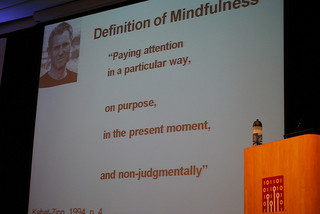|
|
|
Tuesday, December 17th, 2013

It’s almost 2014; a clean slate to do great stuff—but is it really?
Four years ago I identified one reason that change is so difficult, especially when it comes to tweaking/changing culture.
That reason is still with us and is just as much of a problem now as it was then, which means my post is as valid now as it was in 2009.
So, in the interests of a great 2014, here is a little bit of guidance on moving those changes along.
Ducks in a Row: Eliminating Cultural Stuff
I read a fascinating article today about Americans, their stuff and their penchant for storing it instead of getting rid of it.
“The US has 2.3 billion square feet of self-storage space. (The Self Storage Association notes that, with more than seven square feet for every man, woman and child, it’s now “physically possible that every American could stand — all at the same time — under the total canopy of self-storage roofing. …one out of every 10 households in the country rents a unit…”
According to Derek Naylor, president of the consultant group Storage Marketing Solutions, “Human laziness has always been a big friend of self-storage operators, because once they’re in, nobody likes to spend all day moving their stuff out of storage. As long as they can afford it, and feel psychologically that they can afford it, they’ll leave that stuff in there forever.”
I’ve said for years that people aren’t water faucets, able to turn off emotions and thoughts or change their MAP just because they change environments from home to work or vice versa.
Reading the article made me realize a hidden reason that makes changing culture so difficult.
It’s not just that the parts of the culture changes, but that the employees won’t let go of the parts that are changing or being replaced; instead they store them away to sort later.
But later never comes, so, like the stuff in the storage units, it sits in the back of their minds running up a bill that is paid in energy, focus and productivity.
As a result of the economy, many of the thousands of storage units that were in use for no other reason than laziness are being cleared out, or at least downsized, and the stuff gotten rid of.
Perhaps this is a good time to work with your employees to clean out their mental storage places; to purge the cultural residue and clutter that fills them up.
So clear out the rubbish, open the windows and let the fresh air flow through reenergizing everyone.
I’m not saying that change is easy, but I hope this bit of insight will help you fulfill your 2014 vision.
Flickr image credit: Guy Renard
Posted in Change, Culture, Ducks In A Row | No Comments »
Thursday, December 5th, 2013

Entrepreneurs are in love with their technology, whether it’s software, hardware, services, food, etc.
Doesn’t matter, given their druthers they would much prefer to tell you why the technology is so awesome and how it will change the world—or at least a part of it.
That’s OK when talking to another techie, but investors are far more interested in the market.
And, other than cutting-edge outliers, the market doesn’t really give a damn about the technology.
The market is strictly WIIFM or, as Asana cofounder Justin Rosenstein puts it,
“Ultimately everything else we do is essentially a means toward an end of providing the user with some experience. We are really constantly grounding the whole company in that empathy of realizing that all the work you’re doing is a means to an end in service of and dedication to other people, an act of service to help others.”
Asana’s numbers are impressive.
It was founded in 2008 (think Recession), exited beta in 2011 (three years), has over 50 employees and is used by hundreds of thousands of teams from the likes of Twitter, Foursquare, LinkedIn and dozens of others.
It has a valuation north of $300 million.
Asana accomplished all this with just $38.5 million in venture funding—a tiny number by today’s standards.
Read the interview of Rosenstein and cofounder Dustin Moskovitz and their use of mindfulness to create a culture that focused on customers.
Then evaluate the focus of your own culture.
Because no matter how cool your technology, it’s worthless if people don’t/won’t buy it.
Flickr image credit: cambodia4kidsorg
Posted in Culture, Entrepreneurs | 2 Comments »
Monday, August 5th, 2013
LikeHack founder Jane Smorodnikova pointed me to an excellent video about productivity on a blog called Sparring Mind that is owned and written by Gregory Ciotti, the marketing director of a Boston startup called Help Scout.
Some of what’s included
- Why worrying about having “more willpower” is a fool’s game
- How world class experts stay productive… and what they do differently
- The science behind why better energy management = a more productive you
- Big pitfalls that lead to busywork and procrastination
I’m sharing the video, but the accompanying article is worth your time.
I especially like Ciotti’s closing line, “Multitasking is your enemy: Treat it as such. Block out unwanted distractions and as Ron Swanson would say, “Never half-ass two things, whole-ass one thing.”
Based on today’s love affair with multitasking, the number of half-assed things being done could fill the cloud.
YouTube credit: Asap SCIENCE
Posted in Culture, Motivation | No Comments »
Wednesday, June 12th, 2013
 How much management/coaching is too much? How much management/coaching is too much?
I hear that question a lot.
Most managers want to do a good job and are looking for ways to improve.
But, as one commented recently, if you do everything recommended by the experts you would use so much of each person’s time that productivity would tumble and even the best coaching would have a negative impact.
Which is why I say that management and coffee are similar.
In the right amount coffee is good for your brain and may help you live longer.
The right amount of management/coaching is good for the brain in that it provides challenges that foster growth; it also lowers frustration and stress, which enhances mental and physical health.
According to the research, the “right” amount of coffee is around 20 ounces a day, i.e., one venti-size Starbucks.
That equates to the most effective management/coaching, which provides all the information needed to do the job at one time (not more nor less) and then gets out of the way while staying accessible if needed.
Many of the coffee-fueled are more likely to drink three to five ventis a day, which is detrimental to health and longevity.
A comparable amount of management/coaching is detrimental to health, productivity and retention.
Flickr image credit: Kurtis Garbutt
Posted in Communication, Culture, management, Retention | No Comments »
Monday, June 10th, 2013
 Customer service is a major topic these days (more on the tomorrow); as is employee retention, but do they really have anything in common? Customer service is a major topic these days (more on the tomorrow); as is employee retention, but do they really have anything in common?
Absolutely.
Every manager, from team leader to CEO, is also a customer service manager, because your people are your customers.
That’s right, customers.
More accurately, that makes you an ESM—employee service manager.
Why do you service your people? To
- help them achieve their full potential;
- assure high productivity;
- lower turnover; and
- create an environment that’s a talent magnet.
How do you service your people? By
- cultivating the kind of MAP (mindset, attitude, philosophy™) that truly values people and understands how important it is to manifest that;
- offering high-grade professional challenges to all your people and making sure that they have the resources and all the information necessary to achieve success;
- fostering fairness so that people know they are evaluated on their merits and favoritism plays no part; and
- always walking your talk and living up to your commitments.
What’s in it for you?
- Better reviews, promotions and raises;
- increased professional development;
- less turnover and easier staffing; and
- what goes around comes around—everything that you give your people will come back to you ten-fold!
Flickr image credit: Angela Archer
Posted in Culture, Retention | No Comments »
Tuesday, March 26th, 2013
 Yesterday we considered the dangers inherent when employees start thinking of themselves as an extension of the company/manager, as in ““I’m great because my company/manager is great.” instead of, “I’m great and my company/manager is great.”” Yesterday we considered the dangers inherent when employees start thinking of themselves as an extension of the company/manager, as in ““I’m great because my company/manager is great.” instead of, “I’m great and my company/manager is great.””
Today we’ll look at why building people, as opposed to making them dependent, is a smart move and three prime things to help you do it.
People building is imperative, because reputation, both the manager’s and the company’s, is everything when hiring, and being known for your great G&S (grow and strengthen) policies and actions will help you attract, develop and keep the best and brightest.
You’ll still lose some now and then when they’re ready for the next challenge and you can’t provide it, but the benefits resulting from their ultra-high productivity and creativeness during the time they’re with you will far outweigh the loss when they do leave.
G&S isn’t rocket science, nor does it have to be costly.
Here are three basic rules to encourage G&S and discourage ego-merge.
- Treat everyone on your team and in your company with the same level of respect you want.
- Listen to your people. Encourage and assist them as much as possible in developing the skills they need to take their next step—even when it makes your life a bit more difficult.
- Always remind them that for all their successes, challenges, and failures it’s “and” not “because.”
Any manager can implement these and other strategies on her own, whether the company supports G&S or not.
However, it’s to a company’s advantage to fight ego-merge and advocate G&S through its policies, then support it by hiring managers who believe in the power of G&S.
But what if you’re a manager pushing G&S down while your own manager is either blind to it or the type who sees ego-merge as a plus?
But what can you do to avoid ego-merge as a worker with no control or leverage?
Awareness is the best protection against ego-merge. Recognize that it exists, understand what it is, know its symptoms and whether you’re prone to it, then monitor yourself, always remembering that the opposite of ego-merge is not arrogance.
Here’s what you do.
- Post a watch for the first symptom of ego-merge: when your glow of accomplishment for an exemplary project you did is quickly quenched by negative internal news or media coverage. The greater the offset the greater the ego-merge.
- Listen to yourself. When describing a project (successful or not) or coup (large or small), listen to how you describe it and where and how you attribute its success or failure. Adjust accordingly.
- Offset and reduce ego-merge in others by publicly giving full credit to those around you at all levels up and down for their contributions.
Flickr image credit: vetlesk
Posted in Ducks In A Row, Personal Growth, Retention | No Comments »
Wednesday, March 20th, 2013
 Remember the old saying “pretty is as pretty does,” meaning the action dictates the label? Remember the old saying “pretty is as pretty does,” meaning the action dictates the label?
Well, “stupid is as stupid does,” which is especially accurate when applied to management.
It’s hard to know which is most offensive when it comes to management—stupidity or ego, but when they join together the result is…wow; I’m not sure what adjective to use.
You decide.
I received a call from a distraught president. He said the company had been hit with a rash of resignations from some of their best development and marketing people and he had no idea why, since productivity had been running at an all-time high. Would I do some fast debriefing in an effort to turn things around?
It only took a few calls to identify the problem—actually the persons—responsible.
It turned out that the director of engineering and her counterpart in marketing had come up with a unique motivational technique.
They identified comparable projects both inter and intra-department and allowed the teams responsible to make steak and beans dinner bets with each other.
(For those unfamiliar the losing team buys steak dinners for the winning team, while they eat beans and are subject to good natured heckling by the winners.)
The contests had boosted productivity in both departments with most projects finishing early, even under budget, and morale was at an all time high.
The problem came from the fact that the engineering vp and the marketing vp were political enemies and didn’t want their two groups on good terms. Furthermore, the engineering vp felt work was serious business and games undermined his mission.
When they found out what was going on both were furious and agreed to fire the instigators.
That didn’t go over well with the staff, which had no hesitation of protesting with their feet, hence the flurry of resignations.
I reported back to the prez and, smart guy that he is, he didn’t hesitate.
After verifying what I told him he fired the two vice presidents and promoted the two directors.
Because his solution was not only swift, but highly visible, the resignations were withdrawn, the contest reinstated and the approach encouraged across the entire company.
Stupidity and ego; what adjective would you use?
Flickr image credit: opensourceway
Posted in Motivation, Retention | No Comments »
Friday, February 15th, 2013
A Friday series exploring Startups and the people who make them go. Read allIf the Shoe Fits posts here
 I rarely mention ‘leadership’, because I believe that given the opportunity to act anyone can and will step up and lead when the time and cause is right. I rarely mention ‘leadership’, because I believe that given the opportunity to act anyone can and will step up and lead when the time and cause is right.
That’s why I when I coach one of the mantras I offer is “leadership is like manure, it produces the best results when spread around.”
You wouldn’t think founders today would even consider any kind of old world hierarchical management, but they do.
Not overtly, but covertly—and often unconsciously.
It shows in their unwillingness (fear?) to delegate the authority to make decisions along with the responsibility of doing the work.
But there are major advantages to spreading leadership opportunities at every level in your organization.
Foremost is the fact that if you want to hire these days you need to offer your workers meaningful opportunities to grow or they’ll walk.
Growing includes leading and managing—even if it’s only a group of one, themselves.
It means pushing responsibility further and further down in your organization—not just the responsibility—but the authority required to accomplish whatever it is.
And that’s where most founders (and bosses) blow it.
They assign the task, but then require their people to keep running to them for permission to do each step.
I’m not saying to hand over total control, but you need to hand over enough authority to get the job done.
Even when it comes to money, which is often the biggest hang-up, you can still do it.
Create a budget for each task and give the responsibility for spending it to the person responsible for getting it done. Let her decide how to spend it without interference or “help” from you—unless she asks.
If she goes over budget don’t freak out. It’s not that much (or shouldn’t be) in the big picture and if you freak she may never recover.
She already knows that she messed up, so beating on her will accomplish nothing. Sit down calmly and let her walk you through the thinking and decision-making that led to being over budget, discuss it and lead her through a pattern that would have succeeded.
But if it turns out that the error is yours and the estimate was wrong, admit it, don’t try and convince her that someone else could have done it.
People aren’t stupid, she’ll know that the discussion ended as a CYA function for you—as will everyone, since stuff like this never stays secret.
Other great reasons to spread leadership around are increased productivity, more employee satisfaction, fewer logjams when you’re unavailable or traveling, easier staffing and less turnover.
Finally, spread it around because that’s what great founders do—they pay it forward by fostering the growth of more entrepreneurs.
Image credit: HikingArtist
Posted in Culture, If the Shoe Fits, Leadership | No Comments »
Thursday, January 3rd, 2013
Last week I shared Steve Blank’s definition of an entrepreneur and asked if it fit you.
 It fits Alex Kostyrya, a Russian entrepreneur I e-met and have done work for on and off since 2010. It fits Alex Kostyrya, a Russian entrepreneur I e-met and have done work for on and off since 2010.
He’s a great guy and I Skyped him to see what’s been happening, since it’s been awhile, and wish him a great holiday week. (For those who don’t know, all Russian business is closed the first week in January—and I do mean all.)
Alex responded that he planned to relax the whole week.
I said that was good, better if he unwired, and that he would be far more productive when he came back.
I also said that he should be sure his team does the same and he said he would.
Many founders (and other managers) don’t realize that the team is their responsibility and making sure they take down time is important—they will be far more productive and creative if they get away completely (no texts, emails, calls, etc.).
It’s easy to lose site of the human side and needs in the heat of a startup, but when you get right down to it your people are your only real assets.
Alex agreed.
“The people are all I have now. Technologies have changed, the original project is gone, but our core team is the same as 3 years ago. I’m proud because whole last year we all work for nothing, without any financing. Now we have new people on the team and we plan to build a great company with them.”
Sometimes founders need to be tough and make sure their people really do take the time off and that doesn’t mean taking the work home or not take any work home.
It’s necessary because people are like batteries; they need to recharge and their families, friends and the physical world around them is their best generator.
Image credit: Alex Kostyrya
Posted in Entrepreneurs | No Comments »
Wednesday, November 28th, 2012
 The best way to achieve a top performing team is to drug them. The best way to achieve a top performing team is to drug them.
In a good way, of course.
The drug of choice is oxytocin, “a brain peptide known to promote positive intersocial relations” previously relegated to intimate relationships, but, based on new research by Dr. Gert-Jan Pepping, a researcher at the Center for Human Movement Sciences at the University of Groningen in The Netherlands, one that seems to play a significant role in team sports.
“In any social setting that requires some form of social interaction, be it cooperation, trust or competition, we require social information to guide our behavior and a nervous system and associated brain chemicals that are sensitive to this social information.”
While the good doctor is focused on athletic teams what hit me was the applicability to the teams found in businesses of all kinds and at all levels.
Think about it, people tend to separate the personal and professional with language, but call them what you will all human contact revolves around relationships
We’ve all seen or heard about brilliant managers who created teams that went above and beyond and in doing so creamed their competition.
Looking at the companies and teams of managers known for the passion they instill (think Steve Jobs), the high productivity, creativity, drive and fanatical loyalty, both to the company and each other, can you doubt the presence of high levels of oxytocin?
The good news is that oxytocin production is catching, so by being a good boss you can increase the feelings and reactions that produce oxytocin—even among the more lackadaisical members of your team.
“Even when you don’t much like sports, watching others high-five and leap about the living room after their favored team scores will lead “your body to release oxytocin.”
Cheering your team on, recognizing efforts, celebrating accomplishments, both large and small, and other similar actions creates an environment conducive to the production of oxytocin.
But be warned; your people aren’t stupid and will know if you’re faking, so be sure both your attitude and actions are authentic.
Image credit: Wikipedia
Posted in Culture, Motivation, Retention | 2 Comments »
|
 Subscribe to
Subscribe to
MAPping Company Success
About Miki 
Clarify your exec summary, website, etc.
Have a quick question or just want to chat? Feel free to write or call me at 360.335.8054
The 12 Ingredients of a Fillable Req
CheatSheet for InterviewERS
CheatSheet for InterviewEEs™
Give your mind a rest. Here are 4 quick ways to get rid of kinks, break a logjam or juice your creativity!
Creative mousing
Bubblewrap!
Animal innovation
Brain teaser
The latest disaster is here at home; donate to the East Coast recovery efforts now!
Text REDCROSS to 90999 to make a $10 donation or call 00.733.2767. $10 really really does make a difference and you'll never miss it.
And always donate what you can whenever you can
The following accept cash and in-kind donations: Doctors Without Borders, UNICEF, Red Cross, World Food Program, Save the Children
*/
?>About Miki
About KG
Clarify your exec summary, website, marketing collateral, etc.
Have a question or just want to chat @ no cost? Feel free to write
Download useful assistance now.
Entrepreneurs face difficulties that are hard for most people to imagine, let alone understand. You can find anonymous help and connections that do understand at 7 cups of tea.
Crises never end.
$10 really does make a difference and you’ll never miss it,
while $10 a month has exponential power.
Always donate what you can whenever you can.
The following accept cash and in-kind donations:
|






 How much management/coaching is too much?
How much management/coaching is too much? Customer service is a major topic these days (more on the tomorrow); as is employee retention, but do they really have anything in common?
Customer service is a major topic these days (more on the tomorrow); as is employee retention, but do they really have anything in common?
 Remember the old saying “pretty is as pretty does,” meaning the action dictates the label?
Remember the old saying “pretty is as pretty does,” meaning the action dictates the label? I rarely mention ‘leadership’, because I believe that given the opportunity to act anyone can and will step up and lead when the time and cause is right.
I rarely mention ‘leadership’, because I believe that given the opportunity to act anyone can and will step up and lead when the time and cause is right. It fits
It fits  The best way to achieve a top performing team is to drug them.
The best way to achieve a top performing team is to drug them.
